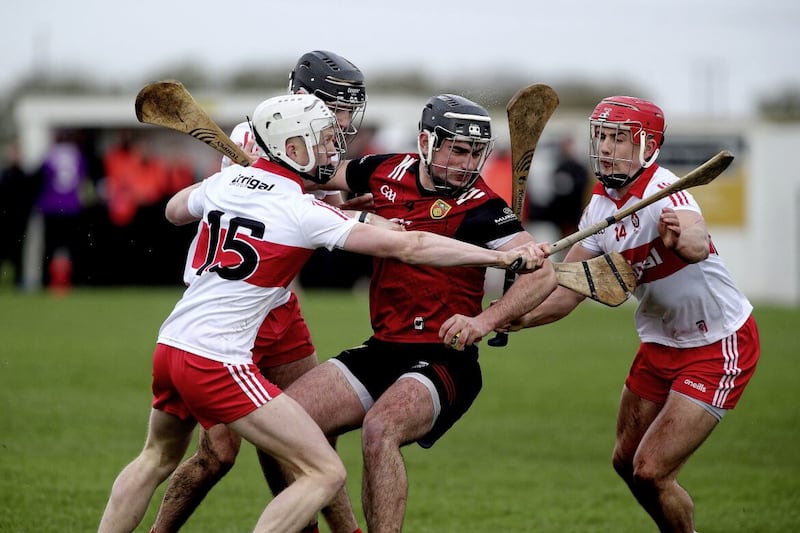IF I had to pick out the player I enjoy watching most these days, I’d have to say that, with a tip of the hat to Stefan Campbell, David Clifford and Shane Walsh, it’s Darragh Canavan of Errigal Ciaran and Tyrone.
After watching his heads-up displays, I can’t help but reach the conclusion that, like his dad Peter, he was born to play Gaelic Football.
A natural with all the skills, he is a connection to the Celtic roots of this game of ours.
As Kenny Rogers sang in The Gambler: “You’ve gotta know when to hold ‘em, know when to fold ‘em…’ and invariably Darragh seems to make the right decisions with the ball in his hands.
Like all forwards, he loves to score but he has that awareness of what’s happening around him and the vision to use the ball cleverly and brilliantly when team-mates run into the space he has created for them.
I watched young Canavan against Killyclogher in the Tyrone championship semi-final and marvelled at how he made his runs and how he used the ball under pressure.
He was always under pressure.
Flares went up and sirens went off whenever Darragh was anywhere near the ball. He was double-marked, he was triple-marked... At one stage, when he dropped deep, picked up the ball and went on a run, I think five Killyclogher defenders took a bite out of him (or tried to) but he still laid it off for his brother Ruairi to score.
That’s no criticism of Killyclogher of course. It was championship football, Darragh Canavan is the dangerman and opposition managers will always be trying to come up with ways of shutting out players like that.
“If we can keep him quiet,” they’ll tell their boys: “We’ve got a chance”.
And there’s truth in that.
Darragh has all the skills but – unlike a Clifford or a Shane Walsh - he wouldn’t be the most physically imposing. His dad Peter was a similar type of player and he flourished in the days when Gaelic Football was mano-a-mano, a one-v-game game between a forward and their direct opponent.
If a defender got physical – which of course they all did – Peter was well able for him and he gave as good as he got.
As we all know, Peter Canavan was a force at the highest level for a decade and more. In the 1995 All-Ireland final he carried the Tyrone attack bravely and brilliantly against Dublin and scored 11 of his county’s 12 points (that’s a shade over 91.5 per cent by the way).
They called him ‘God’ and he won two Sam Maguires including Tyrone’s first, six Allstars, five Ulsters etc, etc, etc but my question is: How would he – as brave and brilliant as he was - have coped in these days of massed defences when you beat one defender only to see two more in your face?
He’d have the same problems his eldest son has.
Darragh Canavan is worth the admission price on his own. But time on the ball for club and county is at a premium because of the defensive systems which are set up to shut him down and deny him the space and the extra half-a-second he needs to thrill the crowds how come to see him play.
Is that what we want?

No-one can coach the innate skills that a Darragh Canavan has but you can take a less talented but totally committed player and make him super-fit. And so the game has become stacked in favour of the man-markers who patrol their defensive zones and wait for a creative player to do his thing and give them a chance to win the ball.
Ultimately what happens is that he stops trying things and takes the safe option. The game is poorer for that.
It’s an issue that Jim Gavin’s Football Review Committee (FRC) is trying to deal with. Creative players don’t get the ball enough and, when they do, they’ll find themselves with no space to play in and simply have to pass the ball backwards to a team-mate.
Some of the seven FRC rules – which will be trialled at the inter-provincial games next weekend - may not make it into the rulebook.
Others may make it but they may not survive. I can see the merit in the scoring arc but I would be concerned that it will be very difficult to police consistently. You shudder to think of a situation late in an All-Ireland Championship final when a player may or may not have had part of his heel touching the 40-metre line meaning that his ‘point’ should have been given as a match-winning two-pointer.
Endless replays back in the studio as the camera zooms in on his boot as a white blade of grass seems to bend slightly…
“Was it the wind? Or is his heel just on the line there Philly?” asks Thomas Niblock.
I’d run a mile if we started going down the video replay route in Gaelic Games.
So the one rule I really hope makes the cut is the one that stipulates that teams have to leave at least three players in the opposition half at all times. This rule will create space for forwards – on both sides – to work in and that will definitely improve the game as a spectacle.
There has to be a place for the skilful players to work their magic. In soccer they’ve done that by making it practically non-contact, we don’t want that in GAA so we have to open up the space and hopefully the ‘3 v 3′ rule will redress the balance between defence and attack.
Over the last two decades we have made Gaelic Football more about physical conditioning and defensive systems and less about skill and creativity.
It’s time to give the entertainers the ball back.









